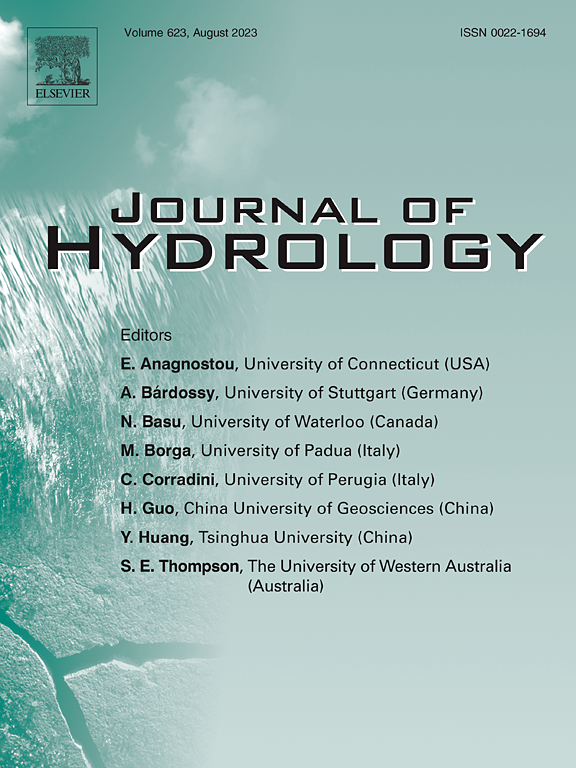对地下水位测绘的再思考:承压含水层固有垂直水力梯度的存在
IF 5.9
1区 地球科学
Q1 ENGINEERING, CIVIL
引用次数: 0
摘要
本研究探讨了内禀垂直水力梯度(IVHG)及其对加强地下水位(GWL)制图的重要影响。IVHG是承压含水层固有的基本特征,反映了平衡条件下垂直水头变化的自然、不受干扰的状态。传统上,GWL制图忽略了承压含水层内的垂直水力梯度,假设承压含水层内任何给定地点的地下水位保持不变,而不管井深如何。该研究发现,在德克萨斯州大休斯顿地区的Chicot-Evangeline含水层中,IVHG约为0.07,而在Jasper含水层中,IVHG约为0.05。该研究提出了一种基于ivhg调整的GWL作图方法,该方法基于井深标准化了GWL测量,从而获得了更精确、更符合深度的GWL等值线。该方法对传统方法进行了重大改进,在水资源管理、保护规划和地面沉降风险评估方面提供了更高的精度,特别是在地面沉降已经停止的地区。IVHG代表了承压含水层内的最小垂直水头梯度。在持续下沉的地区,ivhg调整后的方法可能无法完全捕获更大的垂直水力梯度,但它仍然优于常规制图,可以更准确地表示不同深度的gwl。研究结果强调了在GWL制图中考虑垂直水力梯度的必要性,以获得更精确的地下水评估和有效的管理策略。本文章由计算机程序翻译,如有差异,请以英文原文为准。
Rethinking groundwater-level mapping: The presence of intrinsic vertical hydraulic gradient in confined aquifers
This study investigates the Intrinsic Vertical Hydraulic Gradient (IVHG) and its significant impact on enhancing groundwater-level (GWL) mapping. The IVHG is a fundamental characteristic that is naturally inherent in confined aquifers, reflecting the natural, undisturbed state of vertical hydraulic head variations under equilibrium conditions. Traditionally, GWL mapping has overlooked vertical hydraulic gradients within confined aquifers, assuming that groundwater levels remain constant at any given site within a confined aquifer regardless of well depth. This study identifies an IVHG of approximately 0.07 within the confined Chicot-Evangeline aquifer beneath the Greater Houston area, Texas, and around 0.05 in the underlying Jasper aquifer. This study presents an IVHG-adjusted GWL mapping method that standardizes GWL measurements based on well depth, resulting in more precise and depth-specific GWL contours. This approach offers a critical improvement over conventional methods, providing greater precision in water resource management, conservation planning, and the assessment of land subsidence risks, especially in areas land subsidence has ceased. The IVHG represents the minimum vertical hydraulic head gradient within confined aquifers. In regions where subsidence persists, the IVHG-adjusted method may not fully capture the larger vertical hydraulic gradient, yet it still outperforms conventional mapping by providing a more accurate representation of GWLs at different depths. The findings highlight the need to consider vertical hydraulic gradients in GWL mapping for more precise groundwater assessments and effective management strategies.
求助全文
通过发布文献求助,成功后即可免费获取论文全文。
去求助
来源期刊

Journal of Hydrology
地学-地球科学综合
CiteScore
11.00
自引率
12.50%
发文量
1309
审稿时长
7.5 months
期刊介绍:
The Journal of Hydrology publishes original research papers and comprehensive reviews in all the subfields of the hydrological sciences including water based management and policy issues that impact on economics and society. These comprise, but are not limited to the physical, chemical, biogeochemical, stochastic and systems aspects of surface and groundwater hydrology, hydrometeorology and hydrogeology. Relevant topics incorporating the insights and methodologies of disciplines such as climatology, water resource systems, hydraulics, agrohydrology, geomorphology, soil science, instrumentation and remote sensing, civil and environmental engineering are included. Social science perspectives on hydrological problems such as resource and ecological economics, environmental sociology, psychology and behavioural science, management and policy analysis are also invited. Multi-and interdisciplinary analyses of hydrological problems are within scope. The science published in the Journal of Hydrology is relevant to catchment scales rather than exclusively to a local scale or site.
 求助内容:
求助内容: 应助结果提醒方式:
应助结果提醒方式:


